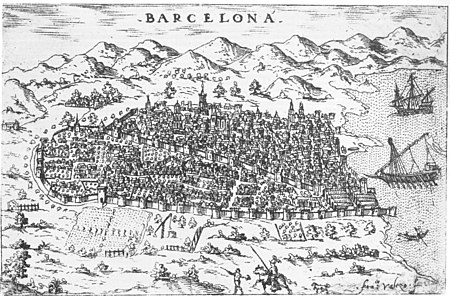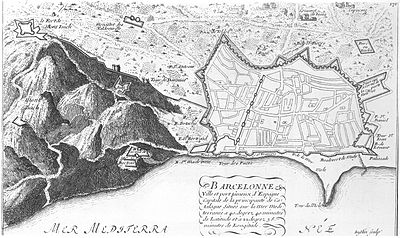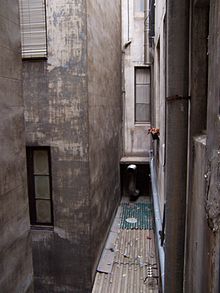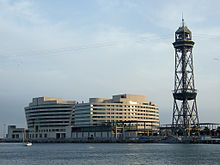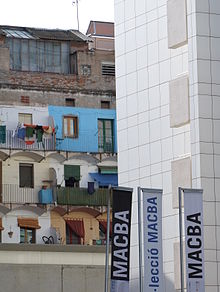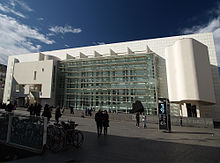El Raval
El Raval [ əɫ rəˈβaɫ ] is a district of Barcelona and belongs to the Ciutat Vella administrative district( Catalan for "old town").
El Raval was incorporated in the 14th century and is one of the most densely populated districts of Barcelona with 42,900 inhabitants per square kilometer. With its dense development of factories and simple apartment buildings from the time of the Industrial Revolution , El Raval was a poor district for a long time. Extensive modernizations since the mid-1980s in preparation for the 1992 Olympic Games have resulted in a significant improvement in the quality of life in many parts of El Raval, but with increasing gentrification . Because of its high proportion of migrants, El Raval is considered the most multicultural district - around 50% of the inhabitants come from around 140 different nations.
etymology
The Catalan noun raval goes back to Hispano-Arabic rabaḍ and means “suburb” or “suburb”, mostly located outside the city walls. The word exists in the Catalan language in the male form ( el raval ), but also in the female form ( la raval ; Balearic dialect: sa raval ). For the Barcelona district, however, the masculine form is always used. The word is used across the board in the sense of “suburb”, but also - as in the case of Barcelona's El Raval - as a proper name.
Limitation
The boundaries of the district run almost entirely along the medieval city wall, which was torn down in the 19th century. Its course was largely based on existing paths from the time of the Roman occupation and ran at the level of today's streets Avinguda del Paral lel , Ronda de Sant Pau , Ronda de Sant Antoni , Carrer de Pelai . A short piece of this wall is still preserved on Avinguda del Paral lel at the level of the Drassanes Reials shipyard . In the east, Raval is bounded by the Rambla - there was also a city wall. Outside the medieval fortification ring, the artificial peninsula Moll de Barcelona belongs to El Raval, which protrudes into the sea in the extreme southeast.
Historical development
Before the incorporation
Until the Middle Ages, El Raval was almost uninhabited and was mainly used for agriculture. Three streets from the Roman era crossed the area, which connected Barcelona with surrounding towns: a street towards Sarrià (roughly today's Carrer dels Tallers ), a road towards Llobregat (roughly today's Carrer de l'Hospital ) and a road towards Montjuïc (roughly today's Carrer de Sant Pau ).
Before the incorporation, there were only a few relevant structures:
- Monestir Sant Pau del Camp (Catalan for "Monastery of St. Paul in the field"): built from 1117; a previous building is said to have existed as early as the 10th century, plus a small village that was directly attached to the monastery.
- Drassanes Reials (Catalan for "royal shipyards"): built from 1280; now house the maritime museum .
- Convent de la Mare de Déu del Carme (Catalan for "Monastery of Our Lady of Carmel"): Built from 1291 by the Order of the Shoeed Carmelites , set on fire in 1835, demolished in 1874, location on Carrer del Carme / Carrer dels Àngels .
- Priory de Santa Maria de Natzaret (Catalan for "Monastery of St. Mary of Nazareth"): Built from 1311, only the small entrance gate in today's Passatge de Sant Bernat - as access to Carrer de la Verge has been preserved .
Incorporation through expansion of the city fortifications
In 1357, the Consell de Cent (a kind of medieval city parliament) asked Peter the Ceremonial (King of Aragon and Count of Barcelona) to modernize the city fortifications in order to better protect himself against enemy attacks. The occasion was Aragon's war against Castile , which began in 1356 . The previously existing city wall from the 13th century was no longer considered sufficient. The king then approved the extensive expansion of the defenses; construction began in 1360.
The urban area of Barcelona was then limited to the relatively small area that is now known as the Barri Gòtic . The expansion of the fortifications was used to expand the city: an additional defensive wall was built in the south-west (far outside the previous city limits on the Rambla ). The existing south-west wall on the Rambla was retained and modernized. The approximately 110 hectare area between the old and new southwest wall was incorporated and known under the name El Raval . This increased the urban area of Barcelona by around 70 percent.
The incorporation took place for strategic military reasons: El Raval still consisted largely of arable land. Since these were now inside the city walls, the self-sufficiency with fresh food was largely ensured in the event of a siege by enemy troops. It was therefore planned to leave the new district largely undeveloped and to use it for agricultural purposes. In addition, the hospitals in Barcelona should be relocated to El Raval. So far they have been in the densely populated city center, which means there is a permanent risk of epidemics, especially from plague and lepers.
"Monastery world"
The original plan to leave El Raval largely undeveloped was hardly adhered to in the following centuries, especially in the northern half of the new district: In addition to hospitals, numerous monasteries and small settlements were built. Especially in the course of the Counter Reformation after the Council of Trento , El Raval developed from the second half of the 16th century to the Tierra de Conventos (Spanish for "monastery world").
Only in the south of the district were there any significant agricultural areas. Their importance became apparent, for example, at the end of the War of the Spanish Succession in 1713/1714, when Barcelona was besieged by Spanish and French troops for 14 months and was urgently dependent on its self-sufficient food supply.
Most of the monasteries in Barcelona (and therefore also in El Raval) were looted and set on fire during the riots of July 1835 (Catalan: Bullangues ). The church property was expropriated by the subsequent disarmortation decrees of 1836 under the Spanish Prime Minister Juan Álvarez Mendizábal . The monk and nun communities dissolved or moved to suburbs. Most of the monastery ruins were demolished and the land was auctioned off to private individuals.
Existing buildings from the time of the "monastery world" (selection):


- Hospital de la Santa Creu (Catalan for "Hospital of the Holy Cross"): Built from 1401, was the central hospital of Barcelona for more than 500 years, today it houses the National Library of Catalonia and the Institute for Catalan Studies .
- Convent de la Mare de Déu dels Àngels (Catalan for "Monastery of Our Lady of Angels"): Built from 1562 to 1566 in the late Gothic style by the Order of the Dominicans , today it houses the private art and design school Foment de les Arts i del Disseny ( FAD) , the monastery chapel is used as an exhibition space by the neighboring museum for contemporary art ( MACBA ).
- Convent de Santa Mònica (Catalan for "Monastery of Saint Monika "): Built in 1636 by the order of the Augustinian barefoot , today it houses the municipal art center Center d'Art Santa Mònica .
- Església de la Mare de Déu de Betlem (Catalan for “Church of Our Lady of Bethlehem”): Built from 1680 to 1732 by the Order of the Jesuits , was considered the most beautiful Baroque church in Barcelona, but the baroque interior was destroyed in 1936 and is still used as a church today.
No longer existing buildings from the time of the monastery world (selection):
- Monestir de Santa Maria de Jerusalem (Catalan for "Monastery of Saint Mary of Jerusalem"): Built from 1453, demolished in 1868, located on today's Plaza de la Gardunya , few ruins were still visible until the square was renovated.
- Convent de Sant Josep (Catalan for: "Monastery of Saint Joseph"): Built from 1586 by the Order of the Carmelite Barefooted (known in Barcelona as Els Josepets - Catalan for "the Josephine"), looted and set on fire in 1835, demolished a little later, The Boqueria market hall has stood in the same place since 1840 .
- Col·legi de Sant Vicent i Sant Ramon (Catalan for "School of Saint Vincent and Saint Raimund "): used since 1758 as a religious school of the Dominicans, set on fire and plundered in 1835, located directly on today's Rambla del Raval (between Carrer de Sant Pau and Carrer de Sant Josep Oriol ).
Demolition of the Rambla city wall
For a long time, the city wall along the Rambla formed a military boundary between El Raval and the rest of the city. Only with the demolition of this wall began the transformation of the Rambla into a boulevard and the gradual urbanization of El Raval. However, the demolition took place in stages over an unusually long period between 1704 and 1829.

The first relevant secular buildings in El Raval were built from 1704 only directly on the Rambla, for example:
- Palau de la Virreina (Catalan for “Palace of the Viceroy”): built 1772–1778; is considered the most beautiful baroque secular building in Barcelona, today it houses the exhibition Els Gegants de la Ciutat (Catalan for "the city giants").
- Caserna de les Drassanes (Catalan for "barracks at the shipyards"): built in 1792, destroyed in 1935; was the central military base in the city center for almost 150 years.
Industrial revolution
With the industrial revolution in the 19th century and the associated rapid population growth in Barcelona, a building boom set in in El Raval. Countless streets and alleys were laid out within a few decades; Manufactories, factories and residential buildings shot up like mushrooms - the density of buildings was soon as high as in the Barri Gòtic. However, this led to mostly inhumane living conditions: In the tenements there was poverty, misery and unsanitary conditions. Most of the apartments were overcrowded and had no running water or electricity. Windows that only led to a tiny courtyard / light shaft were not uncommon. El Raval became a poor people's quarter and partly remained so to this day.
Barri Xino
The southwest half of El Raval was also known as Barri Xino or Barri Xinès . However, there was never a relevant number of immigrants of Chinese origin there. The translations Chinatown and Chinatown are possibly based on a misunderstanding. In colloquial language, chino has the meaning of mestizo alongside Chinese and Chinese .
The Spanish newspaper ABC offered the following interpretation in 1931, which goes back to a journalist named Paco de Madrid:
«Y por eso está bien decirle el barrio chino (...) porque los ladrones llaman chino a la hojita de navaja guíete que llevan apercibida en una caja de cerillas, y usan para cortar el lado izquierdo de las americanas, y llevarse el corazón de la cartera. "
"And that's why the district is rightly called chino , (...) because thieves call the razor blade they carry in a matchbox chino and use it to cut open the left side of the jackets and take the contents out of the wallet."
The term was picked up by various other journalists and novelists and thus established itself in the vernacular. The Barri Xino extends from Carrer de l'Hospital in the direction of the port to Carrer del Portal de Santa Madrona . After the development of El Raval with factories and tenements from the middle of the 19th century, the area quickly developed into an entertainment and red light district. Especially the amusement of the sailors from the nearby harbor could be satisfied here. The Barri Xino was characterized by countless cheap dives, night clubs, brothels and street prostitution. As a result, there were even several specialty condom shops at the beginning of the 20th century. The Avinguda del Paral lel, as the southern boundary of the district, offered a slightly higher standard - with larger theaters, dance halls, cinemas and cabarets. The Paral lel is still fondly touted by tourist guides as the “ Broadway of Barcelona”.
Minor de Barcelona
The Moll de Barcelona (one of the numerous pier) is the only part of El Raval that was not in the medieval fortification ring. The rectangular, artificial peninsula was built from 1877 to 1886 and protrudes almost 500 meters into the Mediterranean. At the top of the pier is the World Trade Center Barcelona (WTCB) - a modern congress center that also houses the 5-star Eurostars Grand Marina . The WTCB opened in 1999.
In addition, the 107-meter-high steel tower Torre Jaume I stands on the pier as a support for the Barcelona harbor cable car .
The pier is of particular importance for shipping traffic: the large ferries to the Balearic Islands and Morocco are handled at the two large terminals to the left and right of the World Trade Center .
Modernization since 1985
The poor and unsanitary living conditions from the time of the industrial revolution persisted well into the 20th century. For example, until the late 1960s, 12 percent of buildings had no running water. Barri Xino , in particular , was considered violent and dangerous because of drug crime, roaming junkies, pimping, and open street prostitution. Large parts of El Raval were a no-go area for tourists until the 1980s .
In 1985 the city council decided to declare the entire old town of Barcelona to be a “zone of urban renewal”. This was done primarily in preparation for the 1992 Olympic Games , when a clean and modern metropolis was to be presented. More than 800 buildings in the old town were renovated, many of them demolished in order to create light paths in the thicket of the narrow streets. In addition, the private renovation of apartments was subsidized. With an increased police presence, the open drug trade and street prostitution were pushed back.
Modernization also continued after the Olympic Games: in 1995 the postmodern building of the Museum of Contemporary Art ( MACBA ) was inaugurated in the north of El Raval , the neighboring Casa de la Caritat was renovated and now houses the Center for Contemporary Culture ( CCCB ). In 2011 the film library Filmoteca de Catalunya was opened in the middle of the Barri Xino . The German Film Days of the Goethe-Institut Barcelona took place there in October 2014 .
The optically most drastic change was the construction of the Rambla del Raval in 1999/2000: More than a hundred buildings were demolished to create a 300 meter long and almost 50 meter wide palm-covered promenade in the middle of El Raval.
Current situation
Through the modernization of the building structure and the establishment of numerous art and cultural institutions, El Raval has at least partially transformed into a student and trendy district in recent years. The Palau Güell and the Boqueria market hall are tourist magnets. Numerous skateboarders cavort on the square in front of the MACBA. In the historic alleys you will find shops for vintage clothing , second-hand record stores and trendy bars and restaurants. Even luxury hotels like the Barceló Raval and the Casa Camper have settled here. The upgrading of the district also partly resulted in a change in the population structure: Long-established residents and poor immigrants can often no longer afford the high housing prices, especially in the north of the district, and are being pushed to the outskirts. In the south of El Raval (the Barri Xino ), however, many poorer people still live, with an above-average number of migrants . El Raval is therefore considered to be the most multicultural district of Barcelona. However, a strong change has been recorded here since 2007, which goes hand in hand with the real estate boom of 2000–2008. Since the Barri Xino borders directly on the central and high-priced promenade La Rambla , real estate investors have been interested in the district since the beginning of 2000.
Population statistics
Multiculturalism
According to the city administration, 47,986 people were officially registered in El Raval on January 1, 2017, of which 49.6% had a migration background . That is by far the highest rate for a quarter in the entire city. The average for Barcelona is 17.7%. People from almost 140 nations live in El Raval. The largest migrant groups come from Pakistan (10.0% of the population of El Raval), the Philippines (8.4%), Bangladesh (5.9%), Italy (3.3%) and Morocco (2.8% ). The homogeneous Bangladeshi community is striking: of around 4,000 people from this country who are registered in Barcelona, around 70% live in El Raval. 372 Germans are also registered in El Raval (0.8%).
Age distribution
The widespread claim that El Raval is one of the youngest districts of the city cannot be statistically proven: 22.9% of the residents were under 25 on January 1, 2016 - this puts the quarter in the upper mid-range of the 73 Barris , but by far not at the top. In Sarrià , for example, the proportion of young people is 28.4%, in Les Tres Torres even 29.9%. Average for Barcelona: 21.4%.
income
The average household income in El Raval as of January 1, 2016 was an index value of only 74.6 (Barcelona total = 100). As a comparison: The tourist-influenced Barri Gòtic had a value of 110.5 in the same year - the noble Pedralbes even 242.4. There are, however, much poorer areas than El Raval - almost all of them are in the Nou Barris administrative district . It is noticeable that household income in El Raval has recently increased significantly: while index values between 60 and 65 were only achieved in the years 2008 to 2014, there was a jump to 75 in 2015, which was just kept up in the following year.
Personalities
- Manuel Vázquez Montalbán - writer, was born on Calle Botella in El Raval. The author and his most tester Roman hero Pepe Carvalho showed repeatedly its close ties with El Raval and for example, were regulars at the restaurant Casa Leopoldo in the Carrer de Sant Rafael .
- Salvador Seguí - an important representative of Spanish / Catalan anarcho-syndicalism in the early 20th century, operated an important contact point for supporters of his movement in El Raval, was murdered by assassins at the intersection of Calle de la Cadena and Calle de San Rafael in El Raval.
- Enriqueta Martí i Ripollés - alleged serial killer, is said to have kidnapped and killed numerous children, especially in El Raval, in order to create a "miracle medicine" from the victims' bone marrow and blood. Nickname: Vampire of Barcelona or Vampire of El Raval .
- Peret - singer, guitarist and composer from the Roma ethnic group , is considered an outstanding representative of the Rumba Catalana ; spent his childhood in a Roma community in El Raval and remained connected to the district throughout his life.
- The German-Catalan actor Daniel Brühl , born in Barcelona, opened a restaurant called Bar Raval in 2011 in Berlin-Kreuzberg .
Remarks
- ↑ Spanish street names at that time; today's Catalan names: Rambla del Raval / Carrer de Sant Rafael . Cadena Street was sometimes also called Calle Salvador Seguí in honor of the murdered man before the beginning of the Franco dictatorship .
Individual evidence
- ↑ http://www.bcn.cat/estadistica/catala/dades/barris/terri/sup/sup416.htm (Catalan)
- ^ Yvonne Kiegel-Keicher: Ibero-Romanic Arabicisms in the field of urbanism and living culture . Max Niemeyer Verlag, Tübingen 2005, ISBN 3-484-52324-7 , p. 147ff.
- ↑ http://barcelonaturisme.com/El-Raval/_xMCfM9AMDl_lKCezjRpMoNEhx38rOUP8Ob0Jr1Lo8XA (English)
- ↑ Juan Gutierrez Cuadrado Verlag = Grupo Santillana de Ediciones (ed.): Diccionario Salamanca de la lengua española . Madrid 1996, ISBN 84-294-4371-1 , pp. 312 .
- ↑ Blanco y Negro: En el barrio chino de Barcelona . In: ABC . Madrid June 4, 1931, p. 52 (Spanish, abc.es [accessed January 12, 2020]).
- ^ Michi Strausfeld : Barcelona - A travel companion. Insel Verlag, Frankfurt am Main / Leipzig 2007, ISBN 978-3-458-34951-8 , p. 131ff.
- ↑ http://www.portdebarcelona.cat/cntmng/d/d/workspace/SpacesStore/e666cc00-3471-486f-809d-98c2f5e46705/Proyectos_Indice_cronologico.pdf (Spanish)
- ↑ https://geographyfieldwork.com/ElRaval.htm (English)
- ↑ http://www.bcn.cat/estadistica/catala/dades/guiadt01/pob01/t17.htm (Catalan)
- ↑ http://www.bcn.cat/estadistica/catala/dades/guiadt01/pob01/t6.htm (Catalan)
- ↑ http://www.bcn.cat/estadistica/catala/dades/guiadt05/pob05/t6.htm (Catalan)
- ↑ http://www.bcn.cat/estadistica/catala/dades/barris/economia/renda/rdfamiliar/a2016.htm (Catalan)
- ↑ http://www.bcn.cat/estadistica/catala/dades/barris/economia/renda/rdfamiliar/index.htm (Catalan)
- ↑ http://www.barcelona-metropolitan.com/features/man-of-the-people-manuel-v%C3%A1zquez-montalb%C3%A1n (English)



